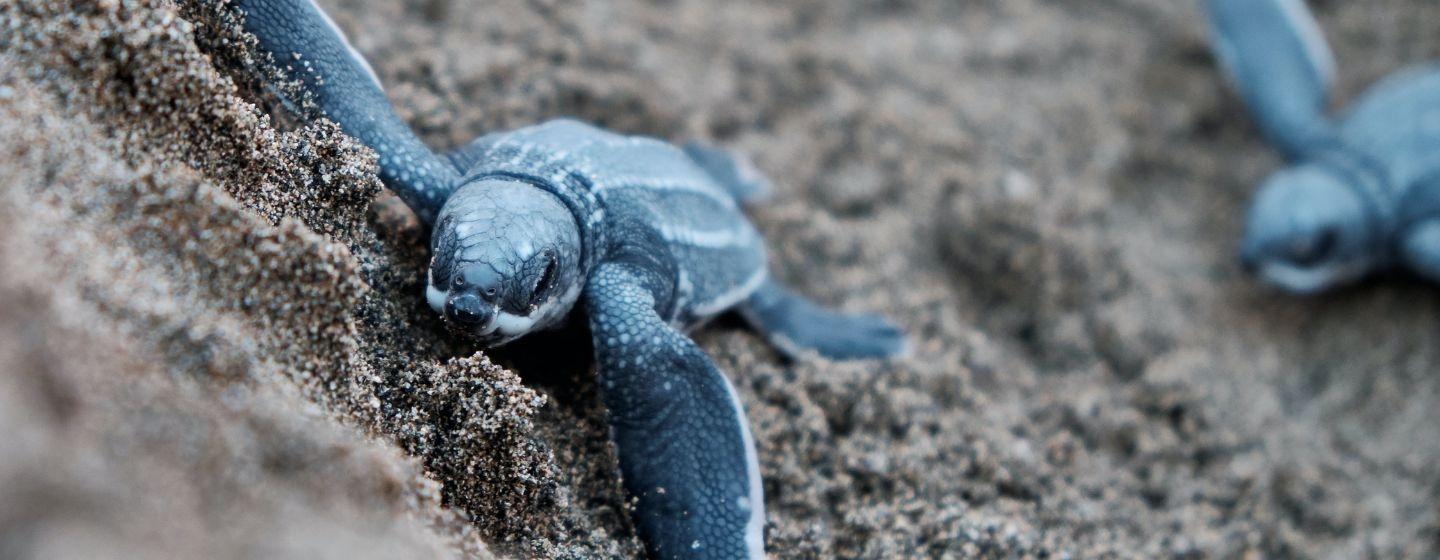A Record Number of Green Sea Turtle Nests in NC This Year


It wasn’t just beach lovers making their way to the surf across North Carolina’s beaches in the summer of 2023. It turns out there were plenty of sea turtle hatchlings scurrying to the ocean as well.
The North Carolina Wildlife Resources Commission (NCWRC) reports beaches all along the state saw 1,725 sea turtle nests during the 2023 nesting season. Nearly 94% (1,619) were loggerheads, about 6% (95) were green sea turtles, with the rest split between Kemp’s ridleys and leatherback turtles (53 each).
For reference, the average annual number of loggerhead nests over the past decades was roughly 1,200 nests. While the numbers of Kemp’s ridley and leatherback turtle nests increased slightly, the number of green sea turtle nests saw a dramatic increase. The average annual number for the past decade was 32.
Scientists admit they don’t know a specific reason, but they’re happy to see the numbers jump.
“Sea turtle conservation is a long-term project, and it’s possible that the protections put in place years ago are starting to bear fruit,” said Matthew Godfrey, Ph.D., a sea turtle biologist with the NCWRC. “All sea turtle species that are found in the U.S. are protected by federal and state laws, so their populations continue to recover.”
Data released by Outer Banks Forever, the nonprofit partner supporting the Cape Hatteras National Seashore, Wright Brothers National Memorial and Fort Raleigh National Historic Site, gives even more insight into the turtle time on the beach.
Rangers tracked 378 sea turtle nests on beaches of the National Seashore. Those numbers were included in the NCWRC figures. But here is what’s interesting: park staff counted 39,085 eggs in the nests and estimate 25,000 sea turtle hatchlings scrambled out of the nests to the sea. The average number of eggs per nest was 199, and the average incubation time was 56 days (about 2 months).
“Sea turtles are some of our favorite visitors here in the Outer Banks,” said Jessica Barnes, director of Outer Banks Forever, in a statement. “We’re so grateful to our national park staff who help protect the turtles, their nests and the habitat they need to thrive.”
The good news is that North Carolina wasn’t alone in recording an increase in sea turtle nests. Florida also saw record numbers of turtle nests during the past season, and the numbers of sea turtle nests held steady in South Carolina, Georgia and Virginia.
But the overall good news is tempered by new research from Florida State University that shows the changes turtles are making in their nesting behavior to adapt to climate change may not be enough to counter the impacts of a warmer climate.
“We have already observed that sea turtles are nesting earlier to align with optimal environmental conditions,” said Mariana Fuentes, principal investigator with the Marine Turtle Research, Ecology and Conservation Group at Florida State University (FSU). “Sea turtles in the past have adapted to climate changes by changing the timing of their nesting or the distribution of their nesting sites, but we have found that even if they do change the timing of their nesting, that’s not going to be sufficient to maintain the temperatures of current nesting grounds.”
Warmer temperatures cause lower hatchling success and a greater percentage of female turtles, both of which disrupt the viability of a species. Sand temperatures at sea turtle nesting sites globally are projected to increase by about 0.6 degrees Celsius (33 degrees Fahrenheit) to about 4.2 degrees Celsius (39.6 degrees Fahrenheit) by the year 2100.
The FSU team looked at 24 sea turtle nesting sites around the world. They found that to maintain incubation temperatures, sea turtles will have to nest between 20 to 191 days (about 6 and a half months) earlier or 54 to 180 days later. But in about half the sites, median incubation temperatures will always be warmer than most of the current ranges.
Turtles nesting farther from the equator will be more able to adapt. Researchers did not look at population viability in the study, but it follows that if fewer hatchlings are being produced by the end of the century, there will likely be sites with lower hatchling productivity.
Researchers did not look at what effect sea level rise may have on nests. This past summer, park rangers moved several nests to higher ground in the Cape Hatteras National Seashore to keep them from being flooded.
“Skeptics may say that sea turtles have been around for a long time, and they have adapted, but the rate of change is much faster now,” said Fuentes.